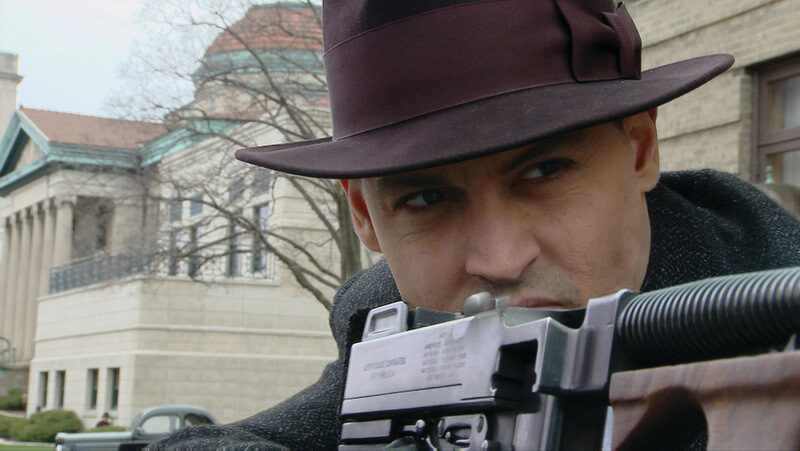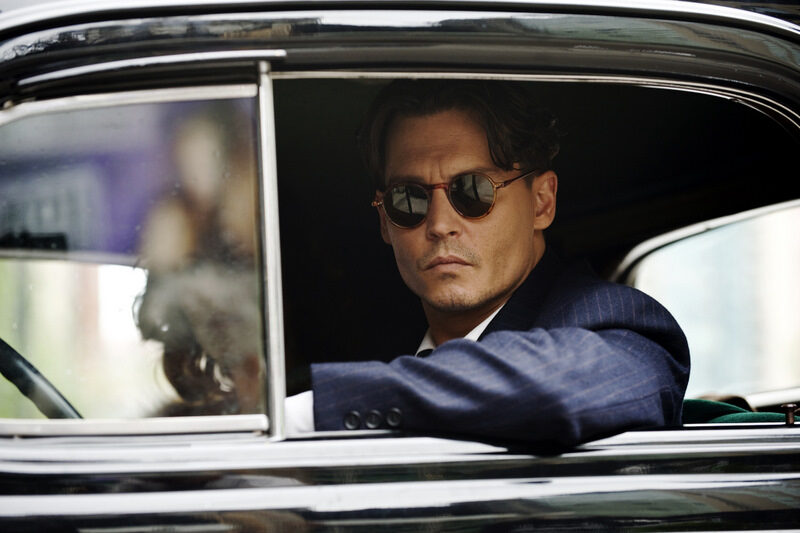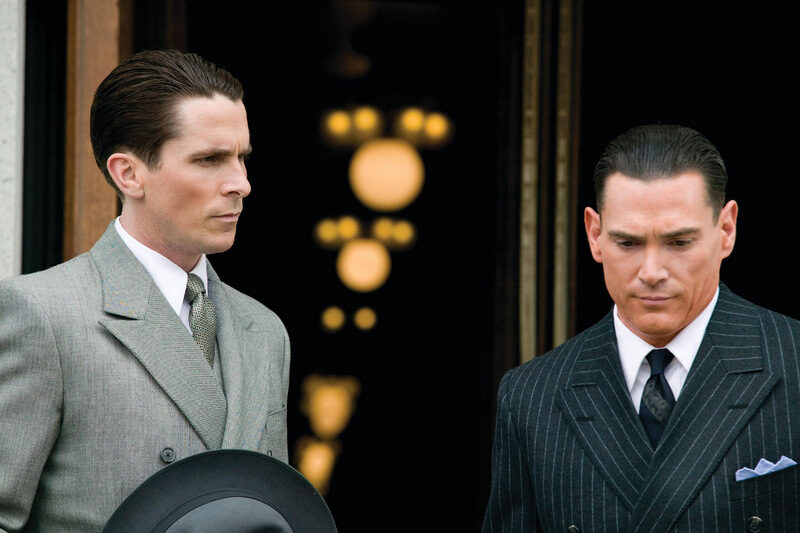Johnny Depp in Public Enemies: Costume as Plot |
Public Enemies (2009, directed by Michael Mann) is chock full of accurately recreated and as such eminently covetable, early 1930s era garments, as designed by multi Oscar winner Colleen Atwood. Perhaps most enticing of all, however, is how one particular garment, a plain wool overcoat, actually powers the narrative of the film. It is the coat that killed John Dillinger.
When we meet John Dillinger (played by Johnny Depp), his criminal career, primarily as a bank robber, is in full swing. He is wearing that conspicuous badge of honour for all those in his ‘gentlemen’s’ fraternity – expensive clothes. They were the ‘bling’ of their day and tended to be as loud and against accepted norms as possible, taking all manner of liberties in cut and colour, including extra wide trousers, thick turn-ups, fat neckties, loud stripes and patterned shirts.
Yet Atwood’s Dillinger is not overly concerned with rebellious display. Far from being influenced by movie gangsters of the time such as James Cagney and Paul Muni, and despite being enthralled by them, Dillinger is sartorially his own man. His revolts include windowpane check suits and coat, acetate and wire frame sunglasses (one-off reproductions) and an oxblood fur-felt fedora (Optimo), but generally that is his taste limit. There is a paradox too, that Dillinger is somehow informed by the onscreen gangsters he himself inspires. However, as usual, Hollywood exaggerates to embellish. Dillinger is Muni in many respects, just quieter.
In contrast to Dillinger, the man tasked with tracking him down, Bureau of Investigation agent Melvin Purvis (Christian Bale), is even more restrained. Bale’s costumes become notably more luxurious as the story progresses, presumably in line with his more public image, yet are mainly of the uniform double breasted or ‘DB’ style, wide in the shoulders with extra padding and a long line jacket tapered into the waist. This came to be known as the ‘The London Cut’ (eventually ‘American Cut’ after it was patronised by movie stars). It was developed by London and then Savile Row tailor Frederick Sholte as a masculine riposte to the ‘dressing soft’ idle playthings of the twenties. It was a serious cut, most befitting a tall, athletic frame.
Perhaps the clearest example of this type of suit on screen is worn by Bureau of Investigation director J. Edgar Hoover (Billy Crudup), as a light grey, 6-on-2 DB, as he introduces Purvis to the press. During a later scene when Purvis meets Dillinger for the first and only time in Indiana, he steps away from the jail cell with both hands in his trouser pockets. Without vents, his jacket crumples to the rear, something that also affects Cary Grant’s suit in North by Northwest (1959). This cut was designed to be worn upright and ready, not slouching with a cocktail.
The central female character in Public Enemies is Dillinger’s girlfriend Billie Frechette (Marion Cotillard), styled to look somewhat like Myrna Loy. Billie is singled out when they first meet in an uppity restaurant for wearing a “three dollar dress” – basically ruby red crepe in a sea of evening blue and black lace. Dillinger’s first gift to Billie is a herringbone wool, fur trim coat. This is currency. Clothes denoted who you were, not literally flashing cash. Like the gaudy urban gangsters of today, you wore your money on your sleeve.
The garment that seals Dillinger’s fate is not especially memorable; a charcoal, herringbone wool (32oz), double breasted, full length overcoat in dark grey made by ‘Shragge Quality’. Yet this is the point; the Bureau does not pursue Dillinger from a pink and yellow silk scarf or exotic tie pin, they use then advanced investigation techniques to find Public Enemy Number One with an overcoat. Admittedly high end and handsomely stitched, but an overcoat all the same.
Dillinger removes his coat after having robbed a bank and taken a young woman, Barbara Patzke (Emilie de Ravin), hostage. He wraps it around Patzke so she stays warm when left behind waiting for the police to arrive (he also wraps his coat round Billie moments after meeting her). Dillinger the protector; he lives for validation from the public. Towards the end of the story a member of his gang proclaims that “the whole country thinks you’re a hero”. No response from Dillinger, though one suspects he found it difficult to suppress a smile.
Bureau officers begin their hunt by cross referencing where Dillinger could have bought the coat with known criminal associates in the area. They manage to ascertain that he has either passed through or was hiding out there. Point being, they had a lead. From this juncture Dillinger is on the run with the Bureau only days behind. He is eventually caught, he escapes, is caught and then escapes again, but fundamentally his time is up. It was not a perverse act of kindness that triggered his downfall; it was a desperate need to be the peoples’ hero. Really, Dillinger wanted to be loved.
Playing the masculine hero was relatively easy for Dillinger, being as most of his associates, including infamous Baby Face Nelson (Stephen Graham), were borderline psychopaths. Public Enemies upholds the pursuit of masculinity as a flawed ambition. At one point in the narrative, Billie dresses as man, or certainly in the male silhouette with fedora and unbuttoned fur coat, to evade the Bureau and run to Dillinger.
When Billie is arrested and tortured for Dillinger’s whereabouts, an agent repeatedly beats her through embarrassment of having his own limp masculinity threatened. As she pleads to use the bathroom, he refuses. She is unable to hold her bladder and he chastises her like a disgusted parent. Billie’s ingrained femininity threatens him; he knows, deep down, that he is not a man, not a man like Dillinger. Not the man a beautiful woman falls in love with. Masculinity may be failed ambition, but femininity is a threat to those who fruitlessly pursue it. This is punished by indignity.
John Dillinger, as portrayed here, was an uncomplicated man, had relatively modest financial ambition and genuinely could not see that he was living on borrowed time. By the end of the film he is even planning his next big score. Dressed in summer linen, his face partially obscured beneath a straw boater, Dillinger cryptically alludes that he “will have to go a lot further than Cuba” to escape his pursuers. His expression watching Clark Gable in Manhattan Melodrama at the cinema says it all: wherever you’re going, go calmly and go quickly.
You can watch Johnny Depp in Public Enemies at LOVEFiLM.com.
© 2011 – 2013, Chris Laverty.









